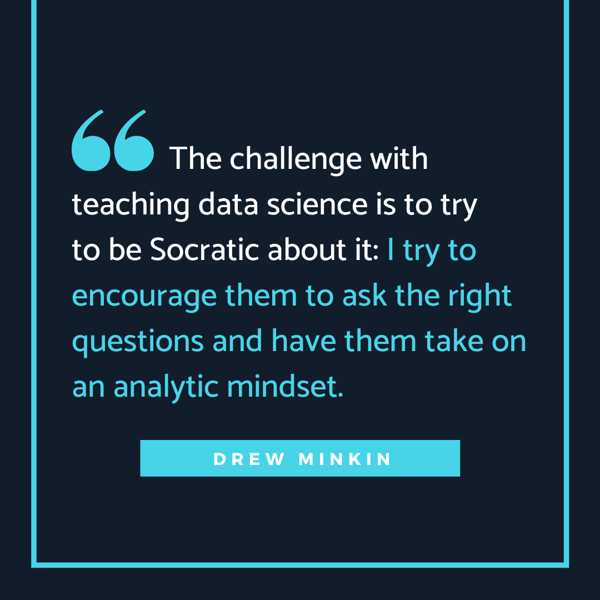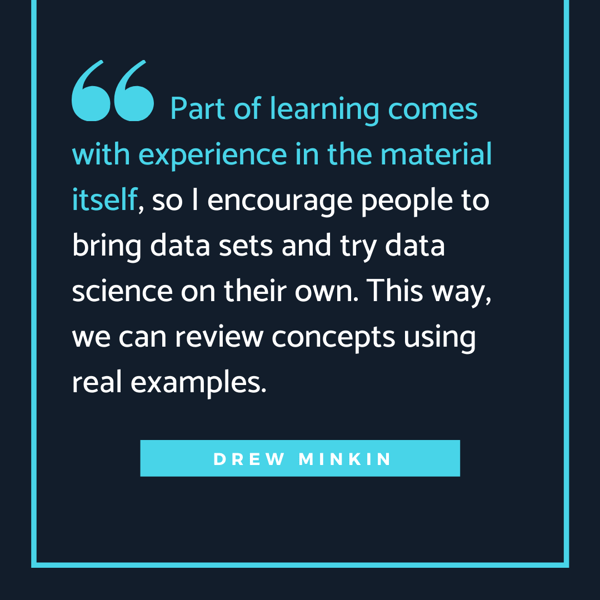Divergence Blog
Latest
- Red vs Blue: Decoding Cybersecurity Team Roles
- From Teacher to Tech Pro: Your Guide to a Rewarding Career Transition
- Navigating the VET TEC Pause: Choosing the Right Path for Tech Education.
- The Future of Work in the Age of Quantum Computing and AI
- What is Capture the Flag?
- KQL vs SQL
- How to Advance Your Career with Advanced Postgres
- Alumni Series: How Michael Williams Became a Cybersecurity Pentester
- A Veteran Success Story with Antonio Grant
- Leveraging a Cybersecurity Bootcamp to Launch a Career in Tech
Meet Our Instructor: Drew Minkin, Data Science and Analytics Expert
“The craft of analytics is across industry experience and is at the heart of most entrepreneurial work. Because of this, I encourage people who are being tapped to go for a promotion, to get surgical on their focus. There’s going to be tool sets, data sets, and problem types that will help the students understand what he or she needs to do to climb the corporate ladder.”—Drew Minkin
Drew Minkin is a Data Science and Analytics instructor at Divergence Academy. With decades of experience in different tech and AI companies from startups to Fortune 500s, he is now a subject matter expert on SQL, BI, SharePoint, and several .NET development exams.
Can you briefly describe your professional background for our readers?
My first instructing experience was while I was in high school back in 1985, where I would teach high school students computer subjects during the weekend.
My first technical experience as a data scientist started in 2005, where I was putting myself through school to understand the context. During this period, I was more of a Business Intelligence (BI) guy in companies. I wasn’t a full data scientist practitioner until 2010.
After my first startup, I taught two programs at Southern Methodist University (SMU) in their business analytics program. During that time, I was helping people learn how to transition from databases to data warehouses and cubes. From there, I was involved with four consecutive predictive analytic and AI startups up until 2019.
At that point, I left the venture capital world and started working as a data scientist at AT&T. When my job contract didn’t look like it was going to be renewed, I started to look for other full-time employment and that’s when Sravan suggested Divergence Academy’s weekend classes as an opportunity.
When I joined, I taught five classes out of the eight in the original set, and I’m doing eight out of 10 in this next series.
What is your degree in?
I actually have a Bachelor’s degree in History of Religions.
Before I fell into coding, I was a computer graphic artist. During that time, my company had me write up my first report in PostScript. And, usually, you do simpler things for reports. Because of that, I had a steep learning curve and I didn’t take a formal programming class until I was a full-time employee at Microsoft.
If you watch the show The Magicians, I would call myself a hedge witch. In that show, there are magicians that aren’t cool enough or privileged enough to get into the school or to have connections; they’re like street magicians who have their own unorthodox style.
I am a street smart person, as far as my computer science experience goes. Starting at the BI and data analytics field and having to go through on-the-job training, I also have a very different, holistic perspective.
I don’t think I was actually part of a formal dev team as an architect or consultant until 2012, early 2013.
In an industry where many have walked a more conventional career path, it seems refreshing to have a perspective that comes from a different background.
I’ve had to fill in some gaps on my own to round out my statistical and computer science education. I think I tend to be a lateral thinker. A lot of times I have different insights that aren’t always obvious to some people, but I don’t think that it’s an ontological challenge. Rather, I’m used to thinking more holistically.
Could you describe your teaching style? Walk me through how you explain terminologies and more obscure concepts within data science.
I probably err on the side of over-contextualization, because I try to give too much of history and give more context on why Power BI has a weird interface, or what people care about in different kinds of phases.
I have what I call my magic chalkboard, which is a MacBook where you can record movies from an iPad connected through the USB. I can basically use it like a chalkboard with a pencil.
Over the series of five courses, I have done over 100 different drawings to walk people through lots of different architectures that you have to deal with and processes. I try to bounce between teaching them the big concepts and also tackling the details.
The challenge with teaching data science is to try to be Socratic about it: I try to encourage them to ask the right questions and have them take on an analytic mindset.
And I think, given how we’ve included business context in the new curriculum, we are in a better position to encourage the kind of engagement that prompts students to ask more questions. This helps hone those soft skills that are necessary for the workplace: how to deal with different types of personalities, how to present the data to executives or C-level management and adjust your narrative style to your audience.

Generally, I try to stick to metaphors and real-world examples to make sure they understand the big picture.
Coding-wise, I try to expose people to it. Sometimes I take the entire class through the notebooks, explain the concepts and what they need to note about the code. Granted, it is not the most exciting way to engage, but we have to get through the icky details to understand the interesting conversations around data science.
This also means encouraging active participation in the classroom. I was always the guy sitting in the first row in class, asking questions to the professor like there’s nobody else in the room. I personally thrive off that kind of dynamic, but I found that it’s not normal for my cohort of students who primarily come from the military.
Why do you think that is?
Because they’re used to a chain of command—they follow orders. There needs to be an unlearning of that trait to drive productive discussion.
Got it, so how would you recommend they go about “unlearning”?
I find that when there’s a lot of jargon and not enough context involved, learners that haven’t been in a software development or IT role may not understand what certain things are, how they’re built, and what people do with them.
Part of learning comes with experience in the material itself, so I encourage people to bring data sets and try data science on their own. This way, we can review concepts using real examples.
And in light of the new capstone structure and the inclusion of business contexts, we now have a more engaging way to explore on-the-job applications for the concepts we cover in class.

Designed to encourage critical thinking, problem-solving, and the development of a variety of skills, a capstone project is a culminating academic and intellectual experience at the end of a learning pathway. It helps learners prepare for modern careers and adult life and can take a wide variety of forms, often in a final product, presentation, or performance.
Can you walk me through an average day in your class?
I try to get people’s questions first thing in the morning, because little things like interviews or exams may come across during the lecture.
That said, I’ve always encouraged people to interrupt me if they have questions that come up in the conversation. I also try to alternate between presentation and discussion sections before labs.
I don’t try to waste time in classrooms on videos, because they can look at videos by themselves. I look for things that can add value to what we already have and stimulate conversations there.
How do you keep students engaged in a virtual classroom environment?
I consider myself a pretty warm and generous teacher, so I do lots of one-on-ones with my students. However, the fact of the matter is that there’s so much material and so much experience to transmit.
Because of this, I decided that I’d rather make sure we cover more material and make time for questions for people that are synthesizing the material, and assume that they’re either on board or that they’re gonna reach out for a one-on-one.
About half of my last class had one-on-one mentoring or tutorials with me either on Python or on some concepts in data science. Divergence’s personalized engagement model emphasizes my role as a resource to empower our learners, not to be a taskmaster to those who already have Master’s degrees.
Divergence Academy transitioned to fully remote-live training back in March. How did COVID impact the way you taught class?
I was on campus for a total of six days before transitioning to full remote-live. I went from driving to work to working on an iPad, and I couldn’t pace as much. I felt more self-conscious about bad jokes and puns that I would throw, because it’s hard to read a class if you’re not in the same physical space.
What do you enjoy most about your work?
It is refreshing to reflect on my career in analytics and know that I am helping accelerate individuals in their pursuit of a better career outcome. I know what I struggled to discover on my own and the mistakes I’ve made in my career.
I also enjoy seeing students grow from being afraid and unsure of their potential to talking the talk and walking the walk. To see that transformation for a lot of people is great, especially when I know that they are also putting in a significant amount of effort.
The majority of the students in my classes have Master’s degrees and are consultants by trade, so they may already have pretty decent businesses. However, I had one learner who was a delivery guy for FedEx and he will likely double his income if he continues pursuing data science.

Wow, good for him! And so for those individuals who want to pursue a career in data science, what is the best advice you can give them?
The craft of analytics is across industry experience and is at the heart of most entrepreneurial work. Because of this, I encourage people who are being tapped to go for a promotion, to get surgical on their focus. There’s going to be tool sets, data sets, and problem types that will help the students understand what he or she needs to do to climb the corporate ladder. That’s one track.
You can also think outside of the box and learn the “science” part of data science. Having a curiosity about the data and how things work together is going to help you add analytic opinions and insights in the shapes and calculations. Getting into that experimental mindset is very helpful.
Doing a data science project by yourself is also another way of accelerating your experience because you may not get that opportunity in a day job. That way, you can move up directly into a position you want.
We are the leading vocational trade school for emerging technologies with industry experts as our instructors. Gain relevant skills and meet the demands of an evolving landscape by signing up for our courses today.
View our course catalog or reach out to us and speak to a Divergence team member today!
